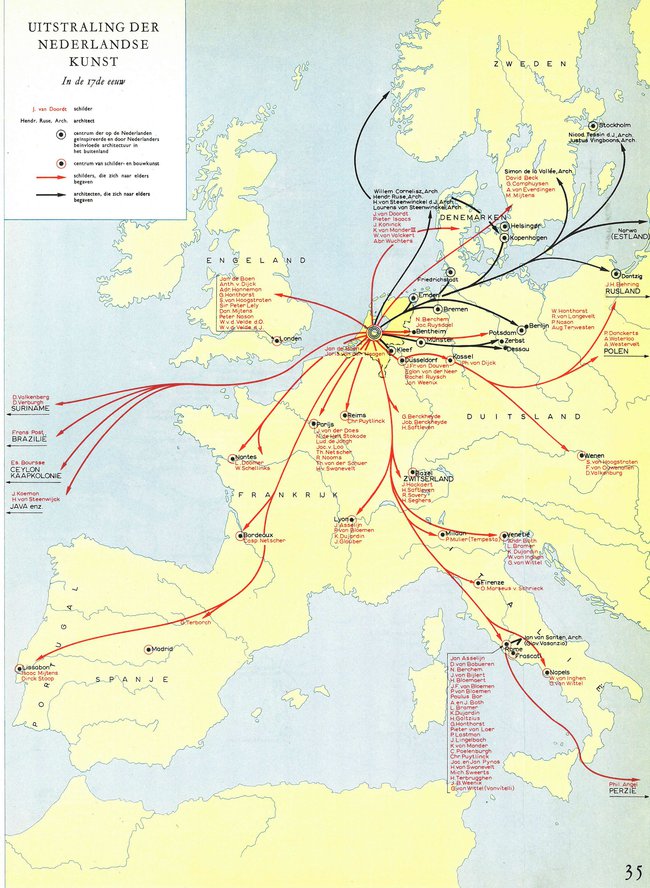2.2 Gerson and Geography of Art
Instead of nationalism, Gerson’s book may be related to another intellectual current in art history that remained strong until 1942, as marked by the publication in the same year of Dagobert Frey’s Das Englisches Wesen in der bildenden Kunst.1 This was Kunstgeographie, geography of art. This topic was treated in many books and articles by scholars in Poland, Sweden, Czechoslovakia, Austria, Germany, France, and Spain. Indeed, artistic geography was the second major theme of discussion at the 1933 International Congress of Art History. Although the geography of art was handled by many scholars as it was by Frey as a form of nationalist, racist, or ethnic special pleading, this was not always the case. Gerson was in this regard far removed from Frey. Frey realized the implications of his pre-war arguments and wartime lectures when as an SS officer he oversaw the destruction of the Warsaw Castle, the plunder of works of art from Poland, and spread propaganda in lectures about how artistic creation in East Central Europe had been German.2 Gerson’s discussion of the spread, movement, and impact of Dutch painting can be related rather to other, more fruitful currents in the geography of art.
Gerson was in this regard one of the first, if not the first, art historian to fully document the international context of Dutch paintings in its world-wide aspect. He was the first art historian to document fully the concomitant notion of Dutch and German painters in motion. The topics he treated with such thoroughness are still matters of concern for art historians at present. Gerson’s place as forerunner of contemporary interests is suggested for instance by the devotion of the 2013 issue of the Nederlands Kunsthistorisch Jaarboek to ‘Netherlandish artists on the move’,3 and of the 2016 issue to ‘Global Art History and the Netherlands’.4 Gerson’s treatment of Dutch artists in Asia and America, with which Die Ausbreitung und Nachwirkung der holländischen Malerei ends, anticipates some recent approaches to global art history. Finally, the new online feature in ‘RKD Explore’ that visualizes the mobility of artists discussed by Gerson may be related to the earliest art geographical attempts to provide a visual or cartographic image for the geography of art.
Although Gerson’s own terms (Ausbreitung and Nachwirkung) may have lost currency, as influence and dissemination may now seem inadequate as heuristic concepts, the issues that he first addressed in his approach to the international aspect of Dutch art history may be regarded as having stimulated attempts to provide other explanatory notions. In their place such concepts as transfer, translation, diffusion, interconnection, entanglement, circulation, mediation, assimilation, and appropriation have been introduced. Since many of them have already discussed elsewhere, including an essay on the Netherlandish model that acknowledged Gerson’s importance, it is perhaps unnecessary to repeat this discussion here.5
A rereading of Gerson nevertheless leaves us with several conundrums. Gerson supplied a thorough and magisterial answer to the prize question, but his book leaves open the question in relation to several issues. While Gerson documented interactions of painters from Holland with other countries, and those from other countries with Holland, he did not account for why it was that this interchange occurred. The quotation from Sir Joshua Reynolds (Painters should go to the Dutch school to learn the art of painting) that he simply set as an epigraph merely demonstrates what he seems to have regarded as a fact, without explaining why this should be so. In fairness, the Prijsvraag did not call on Gerson to answer the question of causality. Nor did it call for further interrogation of the assumption on which it was predicated, that there was a distinctive school of Dutch painting. Yet as we have seen, the issue of national schools is itself problematic.
In any case it seems that Gerson may well have been ill disposed to take on such questions even if he had been free to do so. His orientation to documentary research and connoisseurship, admirably demonstrated in his two other important books, monographs on Philpis Koninck and Rembrandt,6 and his edition of Bredius’s Rembrandt,7 were well suited to his long association with the RKD, but they do not correspond to speculation about causes, or sustained research into cultural history or ventures into over-arching questions of historiography, it would seem. Gerson’s method of procedure by attention to individual artists and places is not only characteristic of his monographs but may reflect a point of view that in his Nachruf for Gerson Justus Müller Hofstede characterized as ‘nominalist’.8

The disseminationa of Netherlandish art in the 17th century
From: J.J.M. Timmers, Atlas van de der Nederlandse beschaving, Amsterdam 1957
Notes
1 Frey 1942. For Frey’s general articulation of Kunstgeographie: Frey 1955.
2 For Frey’s career: Marquard-Twarowski 2016. As Marquard-Twarowski points out, even before the war while working as the Ordinarius for art history at the Friedrich-Wilhelms-Universität, Breslau (now Wrocław) Frey spearheaded the so-called ‘Ostforschung’ on Silesian and Polish art, considering Silesian art as part of the artistic development of the ‘deutschen Ostens’. In a lecture in 1938, Frey characterized the entire ‘östliche Abendland’ as ‘Kunstgeschichtliches Ostmitteleuropa’, thus emphasizing German cultural and artistic origins and influences as the source of cultural and artistic developments in all the European lands to the East of Germany (Frey 1938, Frey 1938A). These tendencies were to become even more acute during the War, when such arguments were used as a basis for the destruction of monuments in German occupied territories or their expropriation by Germans, both actions overseen by Frey himself in addition to giving lectures.
3 Scholten/Woodall et al. 2013.
4 Weststeijn et al. 2016.
5 For instance: DaCosta Kaufmann 2016.
6 Gerson 1936.
7 Bredius/Gerson 1969.
8 Müller Hofstede 1978.

